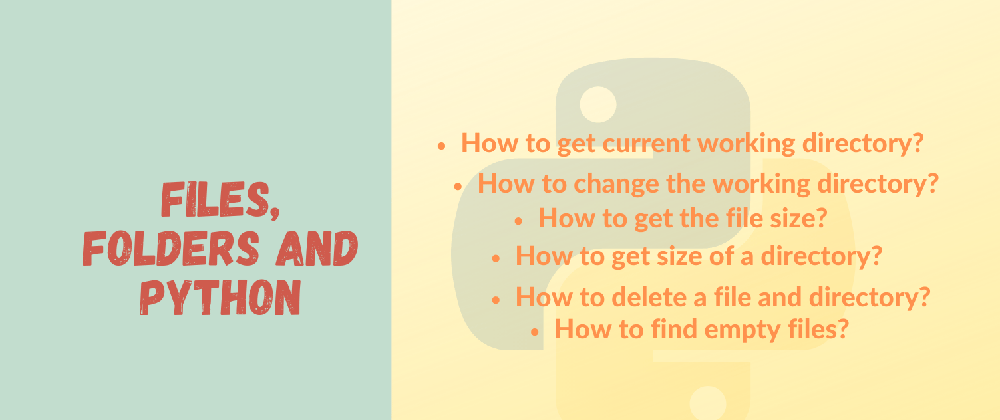In this post we are going to see how we can use Python to find the size of any file and folder. We will check how many files we have inside a folder and how many of them are empty files and how to delete those empty files. We can also check how old a file is and when was the last time file was updated and accessed. We are going to use Python's powerful module os for this. So lets start..
How to get current working directory and how to change it?
First of all, lets import os module.
import os
To get the current working directory lets use getcwd() function
path = os.getcwd()
print(path)
Output: C:\Users\jaqsp\Desktop\other
How to change working directory?
Lets change the current working directory with chdir()
os.chdir('C:\\Users\\jaqsp\\Desktop')
Lets check the current directory once again
print(os.getcwd())
Output C:\Users\jaqsp\Desktop
How to get list of all files and folders inside a directory ?
To get the list of files and folders inside a directory, we can use function scandir. This function returns an object of os.DireEntry. This object represents file path and other file attributes such as
- name : file or directory name
- path : full path of the file
- is_dir() : This function returns True if the entry is a directory
- is_file() : This function returns True if the entry is a file
So lets use scandir() function as shown below
files = []
dirs = []
path = 'C:\\Users\\jaqsp\\Desktop\\other'
with os.scandir(path) as it:
for file in it:
if os.DirEntry.is_file(file):
files.append(file.name)
else:
dirs.append(file.name)
print('Directories: ',dirs)
print('Files :',files)
Output : Directories: ['.ipynb_checkpoints', 'expense', 'git', 'qual-id']
files : ['exp.json', 'files.ipynb', 'Google spreadsheet.ipynb', 'gspread.ipynb', 'my_screenshot.png', 'OS.ipynb']
In the above code, we have created two empty lists files and dirs and then used scandir() function with input path.
We have used is_file() and is_dir() to identify if the entry returned is file or a directory. Finally we appended the list using append function
How to get file size ?
There are two ways to get the file size i.e. using os.path.getsize() function or using os.stat() function. The size returned by each function is in bytes
In below example we will get size of file exp.json
size = os.path.getsize('exp.json')
print(size)
Output : 2313
As shown the file size is 2313 bytes.
How to get file create, update and access date, owner name and size of file
We will use os.stat(file) function to get all the details about a file. This function returns below along with other details. We are not mentioning all the return attributes. Please check this link for all the attributes here
- st_uid : This attribute tells the user id of file owner
- st_gid : This is group id of file owner
- st_size: This is size of the file in bytes
- st_atime: Last accessed time in no of seconds
- st_ctime: File creation time in seconds
- st_mtime: last update/modified time in seconds
Now lets do an example
stat = os.stat('exp.json')
print(stat)
os.stat_result(st_mode=33206, st_ino=24206847997197434, st_dev=4237007564, st_nlink=1, st_uid=0, st_gid=0, st_size=2313, st_atime=1603293698, st_mtime=1602796599, st_ctime=1602796598)
As shown above file size is 2313 bytes and file creation/modification times are in seconds
Lets convert the time in seconds to readable string
import time
time.ctime(stat.st_ctime)
Output: 'Fri Oct 16 02:46:38 2020'
We have used ctime function to convert the time in seconds to string readable format
How to get folder size and empty files
import os
from os.path import join, getsize
path = 'C:\\Users\\jaqsp\\Desktop\\other'
folder_size = 0
empty_files = []
all_files = []
for paths,dirs,files in os.walk(path):
for file in files:
filename = os.path.join(paths, file)
file_size = os.path.getsize(filename)
all_files.append(filename)
if file_size == 0:
empty_files.append(filename)
folder_size += file_size
print('current folder size is',folder_size)
print('total files present: ',len(all_files))
print('Total empty files: ',len(empty_files))
#Print all the empty files
print('Below are empty files found')
for i in range(len(empty_files)):
print(empty_files[i])
Output:
current folder size is 578231
total files present: 230
Total empty files: 4
Below are empty files found
C:\Users\jaqsp\Desktop\other\qual-id\qual_id__init__.py
C:\Users\jaqsp\Desktop\other\qual-id\test__init__.py
C:\Users\jaqsp\Desktop\other\qual-id\test\categories__init__.py
C:\Users\jaqsp\Desktop\other\qual-id\test\utils__init__.py
In the above example we have used Python's walk(path) function to list all the files inside the directory tree by walking either top-down or bottom-up
Then we used join() to join the path and file and return full path of the file and finally we use getsize() function to retrieve size of the file. Folder size in above example is 578231 bytes (564KB)
How to remove a file and directory?
Deleting or removing a file or directory in Python is super easy but make sure you want to delete it as it cannot be recovered once deleted.
To remove or delete a file, Python's os module provides function remove(path). If the input path is directory, it will through an exeception as this function is only to remove a file not a folder.
os.remove('abc.txt')
We can use rmdir(path) function to remove or delete a directory
os.rmdir('some_folder')
Conclusion
Hope this post will help to understand how we can use Python's OS module to do daily activities related to files and directories. We learned how to get current directoy, how to change the directory and how to get different file attributes and also how we can delete a file and directory. Visit my GitHub page for code samples and don't forget to check my other posts.







Top comments (0)